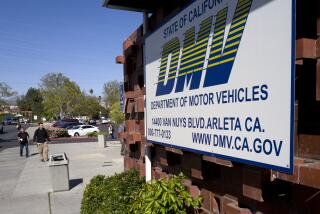A Growing Transportation Gap
- Share via
Hundreds of thousands of Americans are outliving their ability to drive, a new study has found, leaving them dependent on others to provide rides for several years.
“Hundreds of thousands of older people quit driving each year and must turn to alternative transportation,” said Dan Foley, a biostatistician at the National Institute on Aging in Bethesda, Md., and lead author of the study. “I don’t think sufficient attention has been paid to the transition from driver to non-driver in the aging population.”
Nearly 10% of the nation’s drivers today are older than 65. The aging of the baby boomers and an increase in the number of female drivers is expected to yield a growing population of older Americans living longer than they hold a driver’s license.
Giving Up the Privilege
Foley and his colleagues found that the largest number of older drivers giving up the privilege did so around age 85, which suggests that the “oldest old” may be most in need of transportation help. Current projections are that the nation’s 85-and-older population could exceed 10 million by 2030. Although, by that time, some aging experts point out, those who reach 85 may be as healthy and mobile as today’s 65-year-olds.
Dr. Arun Karlamangla, a UCLA geriatrician, said it’s often difficult for non-driving seniors to arrange transportation to appointments. Many of his patients arrange low-cost rides to their medical appointments through Access Services, but often wait a couple of hours for the ride back home, he said. Others rely on relatives, or pay for assistance. “This is going to become an issue, more among the people who are less well off,” Karlamangla said. “We haven’t thought about this as a society.”
Dr. Richard Marottoli, director of the geriatrics and extended care section of VA Connecticut Healthcare System in West Haven, said comprehensive approaches are needed. That means, for example, that when the Department of Motor Vehicles takes away a senior citizen’s license, social services agencies should address the transportation gap left behind.
In the new study, the researchers analyzed data gathered in 1993 and 1995 about a sample of Americans age 70 and older, along with follow-up data on 4,996 male and female drivers with access to a car.
In 1993, 82% of men and 55% of women in that age group were driving. Two years later, 7% of the drivers had died and 9% had stopped driving. Extrapolating from those numbers, it appears that more than 600,000 people age 70 and older stop driving each year because of poor vision, memory impairment or the inability to get around anymore. About 400,000 older drivers die annually.
In their study, researchers found that the rate of those who continued to drive fell from 88% of men in their early 70s to 55% of those 85 and older.
Among women, about 70% were driving in their early 70s, but only 22% continued to do so at 85 and beyond.
Dependent on Others
Foley’s work found that the so-called driving expectancy for an older adult fell short of overall life expectancy. Men and women able to drive at ages 70 to 74 were expected to keep on driving 11 more years; but the men statistically were expected to live an additional 17 years, and the women 21 years.
That means men became dependent on other drivers for an average of six years, and women an average of 10 years. The study appeared in the August issue of the American Journal of Public Health.






